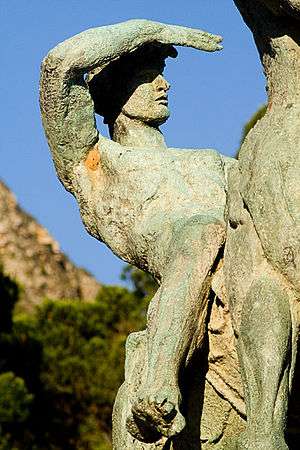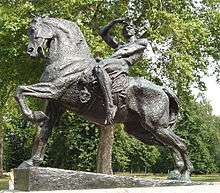Physical Energy (sculpture)


Physical Energy is a bronze equestrian statue by English artist George Frederic Watts. Watts was principally a painter, but also worked on sculptures from the 1870s. Physical Energy was first cast in 1902, two years before his death, and was intended to be Watts's memorial to "unknown worth". Watts said it was a symbol of "that restless physical impulse to seek the still unachieved in the domain of material things". The original plaster maquette is at the Watts Gallery, and there are four full-size bronze casts: two in London, one in Cape Town, and one in Harare. Other smaller bronze casts were also made after Watts's death.
Background
The sculpture is based on Watts's earlier colossal bronze equestrian statue of Hugh Lupus, 1st Earl of Chester, commissioned in 1870 by his namesake Hugh Lupus Grosvenor, later 1st Duke of Westminster. The earlier work was completed in 1883 and displayed at Eaton Hall, Cheshire. That statue was itself based on equestrian elements of the Elgin Marbles.
Watts started work on Physical Energy in 1883. The original 3.5 ton gesso grosso model (made of plaster mixed with glue size and hemp or tow) is at the Watts Gallery at Compton near Guildford. He was assisted by George Thompson and Louis Deuchars. The sculpture depicts a classical naked man on a rearing horse, set on a rectangular wedge-shaped base; the man's left hand holds the reins, while he shades his eyes from the sun with the right as he looks to the left. In the artist's own words, it is "a symbol of that restless physical impulse to seek the still unachieved in the domain of material things".
Physical Energy was the culmination of Watts's ambition in the field of public sculpture, embodying the artist's belief that access to great art would bring immense benefits to the country at large, Watts conceived Physical Energy as an allegory of human vitality and humanity’s ceaseless struggle for betterment.
Watts was reluctant to finalise and cast the work, and continued to modify it. Millais encouraged him to have it cast in 1886, but it was not cast in bronze until 1902.
Casts
The first full-size bronze cast of the sculpture was made at Alessandro Parlanti's foundry in Fulham in 1902. It was claimed to be the largest sculpture ever cast in bronze in Britain. Watts gave the statue to the British Government. It was exhibited in the courtyard at Burlington House for the Royal Academy Summer Exhibition in 1904, the year of Watts's death. It has been suggested that it was then erected at the burial place of Cecil Rhodes in the Matopo Hills in Zimbabwe, but this is not correct. It was transported from England by ship and now stands at the bottom of the steps at the Rhodes Memorial on Devil's Peak above Groote Schuur near Cape Town, South Africa.
A second large cast was made in 1905, at A.B. Burton's Thames Ditton Foundry in London. More refined, it weighs 6 tons, and took eighteen months to cast. It was delivered to London's Kensington Gardens, in September 1907, and unveiled at a site overlooking the north-west side of the Serpentine.
A third full-size version of Physical Energy was cast in bronze in 1959, from the gesso model used for second cast. It differs slightly: for example, the rein appears on the right, like the first cast, rather than on the left, like the second cast. The British South African Company arranged for the statue to be cast at Leonard Grist's Corinthian Bronze Company foundry in London. It was originally located in front of the High Court building in Lusaka in Zambia. It was moved to a racecourse on the outskirts of Salisbury, in Southern Rhodesia (now Harare, in Zimbabwe). Since 1981, it has stood in the grounds of the National Archives in Harare.
A fourth full-size bronze was commissioned by the Watts Gallery for the 200th anniversary of Watts' birth, and cast by Pangolin Editions in 2017 using a new mould made from the original gesso model. It was exhibited near the Watts Gallery in 2017, and then at Burlington House in 2017-18. It is hoped that it will be sited permanently close to the A3, near the Watts Gallery.
Several smaller bronze versions were cast posthumously and sold commercially. One was exhibited at the Royal Academy in 1904. One example by Watts's assistant, Thomas Wren in 1914, sold by Bonhams for £40,000 in June 2014. Others in the collection of the Watts Gallery, at the Laing Art Gallery in Newcastle, the Harris Museum and Art Gallery in Preston, the Walker Art Gallery in Liverpool, and the Gibberd Gallery in Harlow.
In 1960, at the unveiling of the Lusaka statue, Godfrey Huggins, 1st Viscount Malvern presented the Queen Mother with a silver replica of Physical Energy cast from a plaster model made by Sydney Harpley.
Other uses
Rhodes University uses an image of Physical Energy as its logo, and the sculpture appears as a crest on its arms. An image of Physical Energy was used by the Labour Publishing Company Ltd, mainly in the 1920s. An image of the sculpture was used as a trade mark for products such as Energen Rolls in the 1930s. The model of the statue is also used as the logo for the Watts Gallery.
The sculpture was one of the inspirations for Charles Villiers Stanford's Sixth Symphony, composed in memory of Watts.
| Wikimedia Commons has media related to Physical Energy sculpture. |
References
- Physical Energy, Kensington Gardens, London, Watts Gallery
- The Sculpture Collection, Watts Gallery
- Physical Energy Statue, Kensington Gardens, The Royal Parks
- Physical Energy by George Frederic Watts, Victorianweb
- Gigantic plaster horse returns to restored Watts Gallery, The Guardian, 21 November 2010
- Physical Energy by George Frederick Watts, Visit Harlow
- A bronze equestrian reduction of Physical Energy dated 1914, Bonhams, 4 June 2014
- Object in Focus: G.F. Watts, Physical Energy gesso grosso model, Watts Gallery
- Physical Energy at the Royal Academy of Arts, Royal Academy of Arts
- Physical Energy, Royal Academy of Arts